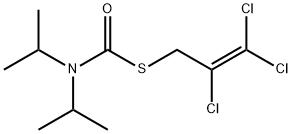- triallate
-

- $0.00 / 25kg
-
2025-04-11
- CAS:2303-17-5
- Min. Order: 1kg
- Purity: 99
- Supply Ability: 20tons
|
| | Triallate Basic information |
| Product Name: | Triallate | | Synonyms: | CP 23426;Diisopropyltrichloroallylthiocarbamate;FAR-GO;FARGO(R);AVADEX BW;AVADEX BW(R);2,3,3-trichloro-2-propene-1-thiol diisopropylcarbamate;2,3,3-TRICHLOROALLYL-N,N-DIISOPROPYL-THIOLCARBAMATE | | CAS: | 2303-17-5 | | MF: | C10H16Cl3NOS | | MW: | 304.66 | | EINECS: | 218-962-7 | | Product Categories: | HERBICIDE | | Mol File: | 2303-17-5.mol |  |
| | Triallate Chemical Properties |
| Melting point | 29-30°C | | Boiling point | 117°C (0.3 mmHg) | | density | 1.273 | | refractive index | 1.5320 (estimate) | | Fp | 2 °C | | storage temp. | APPROX 4°C | | solubility | Chloroform (Slightly), DMSO (Slightly), Ethyl Acetate (Slightly), Methanol (Slightly) | | pka | -1.48±0.70(Predicted) | | form | Solid | | color | White to off-white | | Water Solubility | 4.0 g/mL | | Merck | 13,9669 | | BRN | 1875853 | | LogP | 4.600 | | CAS DataBase Reference | 2303-17-5(CAS DataBase Reference) | | NIST Chemistry Reference | Triallate(2303-17-5) | | EPA Substance Registry System | Triallate (2303-17-5) |
| | Triallate Usage And Synthesis |
| Chemical Properties | Oily liquid. Practically insoluble in water; soluble
in alcohol, acetone, ether, and heptane. Combustible. | | Uses | Herbicide used to control wild oats in lentils, barley, peas and winter wheat. | | Uses | Herbicide. | | Definition | ChEBI: Tri-allate is a tertiary amine. | | General Description | Colorless crystals or oily amber liquid. Toxic by inhalation, ingestion or skin absorption. Used as a pesticide. | | Air & Water Reactions | Readily hydrolyzed by strong base or acid. | | Reactivity Profile | TRIALLATE is an organochlorine carbamate derivative. Carbamates are chemically similar to, but more reactive than amides. Like amides they form polymers such as polyurethane resins. Carbamates are incompatible with strong acids and bases, and especially incompatible with strong reducing agents such as hydrides. Flammable gaseous hydrogen is produced by the combination of active metals or nitrides with carbamates. Strongly oxidizing acids, peroxides, and hydroperoxides are incompatible with carbamates. | | Health Hazard | Highly toxic, may be fatal if inhaled, swallowed or absorbed through skin. Avoid any skin contact. Effects of contact or inhalation may be delayed. Fire may produce irritating, corrosive and/or toxic gases. Runoff from fire control or dilution water may be corrosive and/or toxic and cause pollution. | | Fire Hazard | Non-combustible, substance itself does not burn but may decompose upon heating to produce corrosive and/or toxic fumes. Containers may explode when heated. Runoff may pollute waterways. | | Agricultural Uses | Herbicide: Triallate is a pre-emergent or post-emergent herbicide used to control a variety of annual grasses and wild
oats on several grains, oilseed and vegetable crops. Its use
has been restricted to use in CO, ID, KS, MN, MT, NE, NV,
ND, OR, SD, UT, WA, and WY. Its use on canary grass
has been revoked. Not listed for use in EU countries
.
Registered for use in the U.S | | Trade name | AVADEX BW®; BUCKLE®, (trial-
late + trifluralin); CP-23426®; DIPTHAL®; FAR-
GO®[C]; FAR-GO®; FORTRESS®; OVADEX BW® | | Environmental Fate | Soil. In an agricultural soil,
14CO2 was the only biodegradation identified; however,
bound residue and traces of benzene and water-soluble radioactivity were also detected
in large amounts (Anderson and Domsch, 1980). In soil, triallate degrades via hydrolytic
cleavage with the formation of dialkylamine, carbon dioxide and mercaptan moieties. The mercaptan compounds are further degraded to the corresponding alcohol (Hartley and
Kidd, 1987). The reported half-life in soil is 100 days (Jury et al., 1987). |
| | Triallate Preparation Products And Raw materials |
|